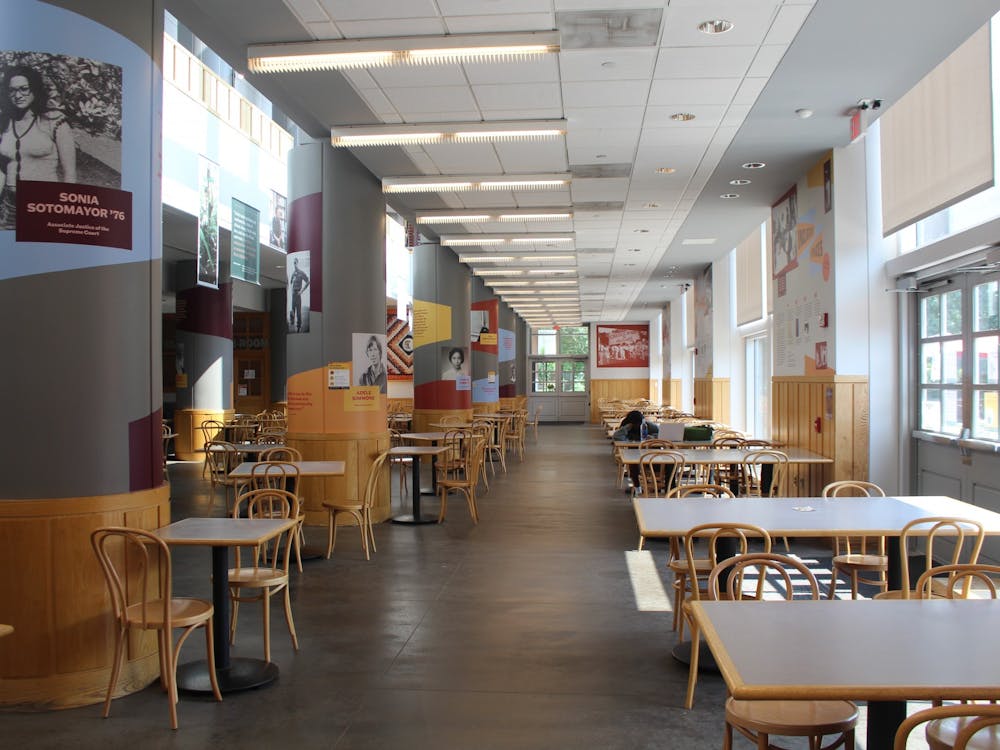Paula Clancy, head librarian for reserves and general periodicals, remembers that when she first arrived at the University 15 years ago, the A-floor reserve reading room was packed with students, especially at nights and during exam periods.
There was a lot of talking and long lines to use the campus phone in the library. "During reading period, you couldn't get a seat," Clancy recalled. Nowadays the reserve reading room is very quiet and Clancy hasn't seen the reserve room packed or long lines at the phones in years.
In contrast, Frist Campus Center quickly became the place to study on campus when it opened in September 2000.
"People are looking for a more comfortable, social place" where they can study and socialize at the same time, Frist director Paul Breitman explained. The campus center's casual atmosphere provides this, he noted, allowing students to interact with others in a social setting that makes them feel more comfortable.
The gravitation of students toward Frist is most evident during exam periods. During these same periods when the reserve reading room used to be full, Frist is open 24 hours a day and packed.
But Breitman cautioned, "We're not competing with the library." Frist is merely "trying to provide a social service" and "alternative space," he said, noting that Frist provides services for the University and being a place to study is one of them, in addition to being a place to interact.
The recent decline in library usage on campus has been dramatic and fits a pattern noticed on college campuses across the nation. Here at Princeton, according to Firestone Library records, the gate count of users at Firestone during this past spring semester declined 19 percent from the previous spring semester. The decline in usage of the reserve reading room has been more spectacular, with a gate-count of just 511 in January 2001, compared with 1,450 in January 2000, before Frist opened.

Jane Bryan, an associate University librarian for public services and collection development, said that while the library might not be the place for social gathering it once was, it continues to be a place to study and get help.
The library still provides quiet places to study, including atrium space on the Band C-floors and the Trustees Reading Room on the main level, studying places that continue to be popular and students are there all the time, she said.
Clancy added that the library also provides carrels, study spaces for seniors with combination locks. Students can check out laptops at the reserve desk and do research work in the carrel. Books can be taken out and charged to a carrel until the end of the academic year, with a "carrel use" stamp placed in the back of the book.
Collaborative study spaces such as those at the engineering library at the Friend Center and Stokes Library in Wallace Hall are popular among students working in groups, and new library spaces will be integrating more of these spaces, according to Kevin Barry, a social science reference center librarian. The engineering library currently has three group study rooms that can accommodate groups of two to eight patrons and can be reserved in advance for up to a two-hour block of time during library hours.

To attract students, the new, to-be-constructed, Frank Gehry-designed science library will contain user spaces that have proven to be popular, according to Patti Gaspari-Bridges, head of the science and technology libraries. "We are planning a variety of user spaces, from soft seating, to carrels, to tables, to group study rooms, to classrooms on all floors.
"We are also planning for an Advanced Technology Room where users can work with combinations of text, images and sound; and a multimedia room with videoconferencing capabilities," she continued.
The library staff is also rethinking public space in Firestone and may create space for more workstations and group study rooms by moving low-volume books to a Forrestal campus location, Barry added.
Because the University requires undergraduates to complete independent work, the drop-off in library usage at Princeton has not been as sharp as at other universities in recent years, Bryan noted.
Students and faculty at Princeton continue to borrow far more books than at other Ivy League schools, taking out and renewing, on average, 132 books each in 1999. This is far more than at Harvard — the Ivy school with the second-highest circulation rate — where students and faculty take out an average of 84 books a year each.
Even so, Firestone staff members have made a conscious effort to persuade more students and faculty to use library resources — whether they are located in Firestone or the library's website.
Firestone subscribes to more than 4,000 online magazines and journals in addition to other electronic articles available through online databases. Online catalogs also make it possible for students to see whether certain books have been checked out from the library, and if necessary, to recall materials charged to other borrowers — all without having to leave home, Clancy said. Course reading materials on e-reserves have been linked to Blackboard, the course support service that the University provides.
One consequence is that students don't need to come to Firestone as often to take advantage of library resources.
That's fine with Barry, who said while the volume of people at Firestone is dropping off, the level of engagement with librarians has increased. The library has become more engaged in advising, he added. Even though fewer students come to Firestone, those who do tend to have more complex questions that require more attention from librarians, particularly with respect to data services and online resources.
"More faculty are viewing librarians as important partners in the advising process," he added, noting that today's databases tend to be more complex and specialized, "This is particularly true in quantitative re-search, where the identification of appropriate data sets and variables as well as choice of tools for analysis are key factors in a successful outcome."
Students "count on the librarians to help them make discriminating and well-informed referrals, neatly matching their lines of inquiry with the most appropriate electronic choices," Barry added.
There has also been more library outreach with librarians going to faculty offices and presenting at classes. The library has established a freshmen explorations program through the freshmen writing program to help students "learn how to negotiate Firestone, the library web and electronic reserves much earlier on" than they would otherwise, he said.
Gaspari-Bridges sounded a positive note that students and faculty would continue to use the physical capacities of libraries on campus. "If we're doing our jobs right by offering needed and timely services, by getting the word out of how we can help students and the rest of the Princeton community twenty-four-seven, by having a place where students and faculty from academic departments can meet and work together, and by having spaces offering technology that may not exist elsewhere on campus — well, I don't think we will have a problem of declining usage at all, in fact just the opposite," she noted.
The book, after all, isn't closed on libraries just yet.







